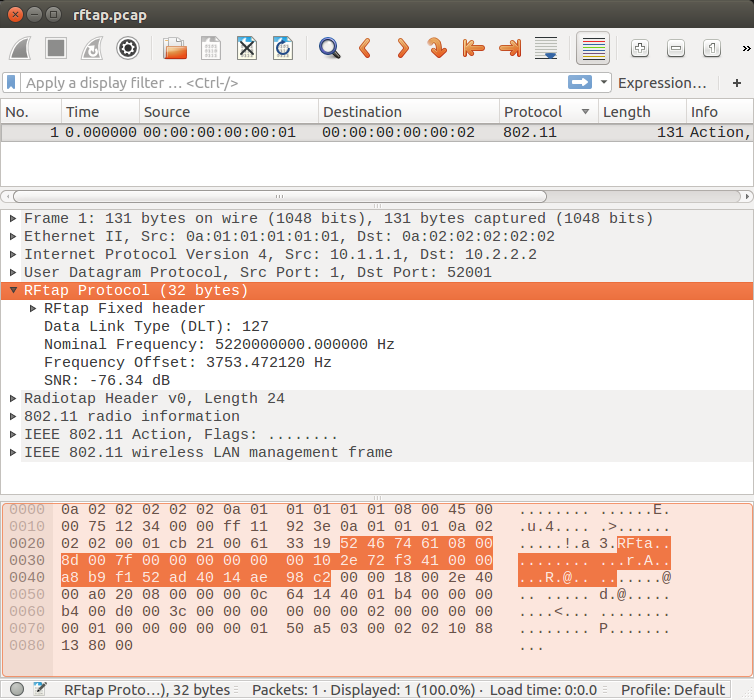Specifications
You may prefer to read the gentler RFtap introduction first ![]()
RFtap Protocol Specifications
RFtap is a simple protocol designed to provide Radio Frequency (RF)
metadata about packets.
RFtap Packet Structure
+---------------------------+
| Magic |
| (4 Octets) |
+---------------------------+
| Length32 |
| (2 Octets) |
+---------------------------+
| Flags |
| (2 Octets) |
+---------------------------+
| RFtap optional fields |
. .
. .
. .
+---------------------------+
| Payload |
. .
. .
. .
RFtap Description
All values are little-endian.
The magic field is a fixed signature used to identify the packet. The
signature is: 52 46 74 61 (hex), i.e. the ASCII sequence "RFta".
The length32 field indicates how many 32-bit words are used by the
entire RFtap header including the optional fields.
The flags field is a bitfield indicating the presence of following RFtap
fields (similar to radiotap "present" flags), or in few cases directly
the value of boolean fields. The bitfield ordering starts from LSB.
Flags bitfield:
0 Data Link Type (DLT) field is present
1 Frequency field is present
2 Nominal frequency field is present
3 Frequency offset field is present
4 The power units are dBm (boolean)
5 Signal power field is present
6 Noise power field is present
7 SNR field is present
8 Signal quality field is present
9 The time standard is UNIX time (boolean)
10 Time field is present
11 Duration of packet field is present
12 Location field is present
13 Reserved, must be 0
14 Reserved, must be 0
15 Reserved, must be 0
Field 0: Data Link Type
Field name: dlt
The Data Link Type of the payload.
32 bit little endian integer.
Example: a Wi-Fi payload would have a DLT of 105.
Note: like all RFtap fields, this field is *optional*, and may not be
present for protocols that don't have an associated data link type.
Ref: http://www.tcpdump.org/linktypes.html
Field 1: Frequency
Field name: freq
The actual (measured) carrier frequency, in Hertz.
64 bit double precision IEEE 754 floating point, little endian.
Example: a Wi-Fi packet received on channel 1 with 13ppm error would
have the value of 2412.031356e6.
Ref: https://en.wikipedia.org/wiki/Carrier_frequency
Field 2: Nominal Frequency
Field name: nomfreq
The nominal carrier frequency, in Hertz (this is the ideal frequency,
ignoring frequency errors)
64 bit double precision IEEE 754 floating point, little endian.
Example: a Wi-Fi packet received on channel 1 would have the value of
2.412e9, regardless of the carrier frequency offset.
Field 3: Frequency Offset
Field name: freqofs
The Carrier frequency offset, in Hertz.
64 bit double precision IEEE 754 floating point, little endian.
Example: a Wi-Fi packet received on channel 1 with 13ppm error would
have the value of 3.1356e5.
Ref: https://en.wikipedia.org/wiki/Carrier_frequency_offset
Field 4: Power measurement units (boolean flag)
Field name: isdbm
True (1): the power units are dBm.
False (0): the power units are dB (this is also known as unreferenced
or uncalibrated power level).
Ref: https://en.wikipedia.org/wiki/Decibel
https://en.wikipedia.org/wiki/DBm
Field 5: Signal Power
Field name: power
Power of the signal, in dB or dBm units.
32 bit single precision IEEE 754 floating point, little endian.
Field 6: Noise Power
Field name: noise
Power of the noise, in dB or dBm units.
32 bit single precision IEEE 754 floating point, little endian.
Field 7: Signal-to-Noise
Field name: snr
Signal-to-Noise (SNR) ratio of the signal, in dB.
32 bit single precision IEEE 754 floating point, little endian.
Ref: https://en.wikipedia.org/wiki/Signal-to-noise_ratio
Field 8: Signal Quality
Field name: qual
Signal quality, in arbitrary units from 0.0 (worst) to 1.0 (best).
32 bit single precision IEEE 754 floating point, little endian.
This is sometimes used as a substitute for SNR, when accurate power
and/or noise level estimation is difficult to implement.
Field 9: Time standard (boolean flag)
Field name: isunixtime
True (1): the time standard is unix time.
False (0): the time standard is not defined.
Ref: https://en.wikipedia.org/wiki/Unix_time
Field 10: Time
Field name: timeint
Field name: timefrac
Computed field name: time (the sum of the two fields)
The event time (the time the packet was received).
It consists of exactly two (2) consecutive 64 bit double precision
IEEE 754 floating point, little endian.
The first number represents the integer number of seconds since the
time epoch.
The second number represents the fractional number of seconds since
the time epoch, between 0 (inclusive) to 1 (exclusive).
Note that the timestamp is generated by the receiver clock (also
called MAC or PHY timestamp), which may not be synchronized to the
computer clock.
Ref: https://en.wikipedia.org/wiki/Epoch_(reference_date)
Field 11: Duration
Field name: duration
The duration of the event (the packet), in seconds.
64 bit single precision IEEE 754 floating point, little endian.
Field 12: Location
Field name: lat
Field name: lon
Field name: alt
The location of the receiver.
It consists of exactly three (3) consecutive 64 bit double precision
IEEE 754 floating point, little endian.
The first value is the latitude of receiver (-90..90 degrees), using
WGS 84 datum.
The second value is the longitude of receiver (-180..180 degrees), using
WGS 84 datum.
The third value is the altitude of receiver, in meters, using WGS 84
datum.
Ref: https://en.wikipedia.org/wiki/World_Geodetic_System
Future extensions:
The protocol may be extended in the future by having extra words after
the last RFtap optional field. Those extra words will be accounted for
in the RFtap length32 field.
Payload
The encapsulated payload follows after the RFtap header. Interpretation
of the payload is dependent on RFtap fields, specifically the RFtap
Data Link Type (DLT) field.

Sample RFtap packet, encapsulating a Radiotap packet
Download Sample RFtap pcap file